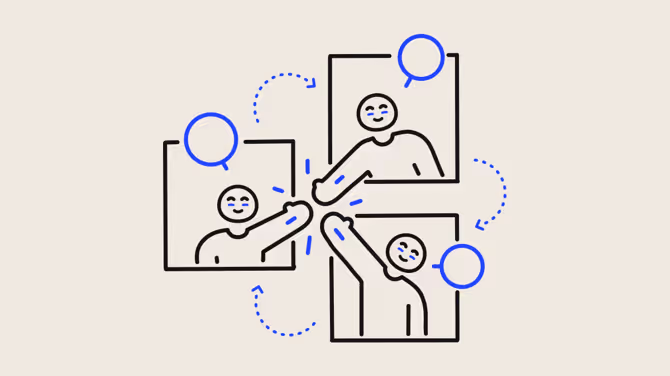How to manage and engage remote employees

Discover Workleap Officevibe's benchmark report on 12 key employee engagement metrics

Here's a fact that might blow your mind: By 2025, 32.6 million Americans, or 22% of the workforce, will work remotely. Today, working from home (WFH) and hybrid work schemes are commonplace, with remote workers enjoying the many perks that remote-friendly companies have to offer — schedule flexibility, commute and childcare cost savings, location freedom, and work-life balance.
Employees are not alone in reaping the benefits. As Dan McGinn, Executive editor of Harvard Business Review, puts it:
Management strategies have to adjust to keep teams near and far engaged, synched, and productive. The good news is that tactics and technology have evolved to meet the demands of a changing workforce.
This article outlines the most impactful ways to engage remote employees — ensuring performance standards and company objectives keep being met even when the office environment is a virtual one.
The importance of team culture and community
Now more than ever, employees want to feel connected to their workplace — to its values and mission, to their peers, to their managers, and to their own careers within the company. This is why younger generations, like Gen Z, value growth and development so much. They are committed to sticking around if it's a mutually beneficial relationship that hits all these cords.
This is no different for remote employees. Just because they're not together physically doesn’t mean they don't value and require the same connection to work culture and community. The importance of a team’s remote working dynamics remains the same — it might just require a bit of working around and creativity from managers to keep supporting them within the bounds of new modern work methods.
3 tips to maintain a strong culture and keep remote employees engaged
When everyone works remotely, employees can start to feel isolated and lonely. This impacts team performance as much as employees’ well-being, so nurturing connection between team members keeps remote employee engagement levels high.
Tip #1. Uphold team rituals and establish new ones if needed
Structure helps create team alignment, but can it also nurture a sense of community and connection? Absolutely. Those daily or weekly recurrences help your team find their rhythm and offer opportunities for human connection. It's about making room for touchpoints when organic moments aren't possible.
Remote rituals can look like this:
{emphasize}
Holding recurrent retrospective team meetings
It's not to say that meetings can't be held ad hoc. But with the unpredictability of the day-to-day, it's a good shout to have a base of planned meetings that happen no matter where the week takes you. Whether weekly, bi-weekly, or monthly, retrospective team meetings enable employees to continually share, validate, and adjust their methods of working together remotely.
Adding employee engagement surveys to the routine
Keeping a pulse on remote employee engagement is crucial if managers want to spot any pain points arising. Not every employee will speak up about a concern or realize if an issue is affecting how they are tuning into work. Making pulse surveys a part of the routine is a great way to gather employee feedback and measure remote employee engagement throughout the year. These types of employee engagement activities communicate that remote employees' perspectives are always considered and that managers are equipped to take meaningful action to support their remote teams.
Blocking out time for non-work interfacing
Remote employees' reality sometimes feels like back-to-back, screen-to-screen meetings all day long. A good way to break up the day's monotony is to carve out time for non-work-related interactions. This ensures the human experience of work doesn't get lost in the shuffle of productivity. This can be done by adding an “opt-in” morning coffee time slot or lunchtime video call for the whole team, so they have a daily opportunity for low-pressure face-to-face connection. These moments help maintain remote relationships and spur those water cooler conversations that lead to innovative new ideas.
Remote team rituals exist to keep a certain standard of direct connection amidst the unpredictability of work urgencies and changing schedules. What works for one remote team might not work for another — the key is to check in frequently with remote employees and rely on their feedback to build a structure that works for everyone.
{emphasize}
Tip #2. Establish virtual communication channels and norms
Communication is at the core of human connection. Setting up a virtual environment for effective and dynamic communication helps remote teams better interact and collaborate.
An effective virtual communication system can look like this:
{emphasize}
Using instant messaging for quick interactions
Not everything should be an email. But remote employees don't necessarily have the opportunity to pop over to their colleagues' desks to ask a simple question. This is where instant chat tools come in handy. Software like Slack offers a dynamic instant messaging experience, with emoji reactions, polling features, and GIF sharing for even more interactivity.
Leveraging video conferencing tools
Speaking to each other face-to-face is one of the most powerful ways to communicate. Tone, inflection, and physical cues help a message come across more accurately. Remote employees lack this opportunity. So video conferencing is the next best thing. When communications via email or chat get muddled or challenging, there should be a collective agreement for remote employees to hop on a video call and sort things out verbally.
Creating a communication channel structure
Remote workers will have access to and need to use multiple communication channels throughout the day (sometimes simultaneously) to stay connected and in sync. As different conversation threads pile on, it's easy to get overwhelmed. Having structures put in place to help streamline communications, be it by topic or by internal communities, is a great way to keep a remote workforce organized.
Having online and offline guidelines
Just like with in-office practices, it's important to set remote communication ground rules and revisit them frequently to ensure they’re relevant. Managers can create an FAQ guide for all things regarding internal communications. What information can be shared via Slack or email, and what requires a phone call or video chat? Are there set times for work focus, and should employees update their online status to reflect their availability?
Part of managing remote employees is establishing effective communication practices that make interacting with each other as clear, smooth, and enjoyable as possible. Managers should make sure a map of communication channels and norms is accessible by all remote team members — and shared during remote onboarding.
{emphasize}
Tip #3. Enhance the remote employee experience
Great employee experience is vital to any team’s success, but for virtual teams, it’s even more essential to keep the employee experience sensational.
Investing in the remote employee experience can look like this:
{emphasize}
Amping up acknowledgement and employee recognition
Remote workers miss out on opportunities to give each other literal pats on the back. Hence why it's necessary to recreate virtual equivalents. A great way to engage remote employees is to amp up employee recognition efforts. Acknowledging good performance through a chat shout-out or during the next video meeting is a great way to boost remote employee engagement.
Sharing to show you care
Like with sharing kudos, sharing news and events occurring within the company reminds remote workers of the mission they all share. Managers should regularly communicate priorities, progress reports, promotions, new talent hires, and company wins to ensure remote employees feel looped in. It's a bonding experience when remote employees share their own good news too, like the arrival of a new fur baby or an exciting trip they've booked.
Adding interactive tools to your arsenal
Ultimately, the remote work experience is heavily reliant on the tools remote workers are provided. While chat and video calls are great, several other software exist to brighten up the remote employee experience — from project management software, collaborative tools, remote team quiz games, and more. More on that further down this article.
By improving the online experience of remote workers, managers help create a company culture of engagement that brings peers together. The more engaged employees feel, the better job satisfaction they experience, which leads to higher levels of employee productivity.
{emphasize}
Screen-to-screen: How to facilitate online meetings
Meetings are a core aspect of working together — remote or not. That said, virtual realities mean adapting to a screen-centric world. From video conferences to online polling and virtual whiteboards, there's plenty of technology out there to help facilitate the interactions of remote teams. Applying best practices and tactics ensures remote meetings can feel as effective and natural as possible.
Setting up teams for success with the right technology
The first step for success: A team's tech setup. While it's important not to overwhelm remote employees with tech to the point of inefficiency, it's important to set everyone up with the right tools to collaborate effectively. In an era of technology abundance, quality over quantity is key.
Look for all-in-one solutions
Seek out software and other tools that integrate within existing company systems. This will provide a smooth online collaboration experience, enabling remote employees to maintain their day-to-day meetings without having to switch in and out of different platforms.
Managers should consider tools that cover multiple aspects of online meetings under one roof. Platforms like Zoom, Microsoft Teams, or Slack provide a multi-channel experience, from video calls to instant messaging features. This streamlines the online interaction process.
User-friendliness and training are key
Technology, no matter how amazing, is useless if it can't be utilized to its full potential. Not everyone in a remote team is a tech wizard (nor should they be) so tools that offer a user-friendly experience are the way to go. Remote work already comes with its own set of challenges — why complicate it?
Ease of use goes hand-in-hand with providing the right training. While remote tools might already be intuitive, not all remote employees might be familiar with them. Allowing for adequate time to onboard and get a hang of new software ensures communication tools are accessible to everyone.
How to effectively run remote meetings
While there are best practices that apply to both in-person and remote meetings — like waiting one's turn to speak or having an agenda — online meetings demand a few adjustments to ensure sustained remote employee engagement and productivity.
Here's how to run remote meetings smoothly and effectively:
Creating a digitally-accessed agenda
Everyone should come to a meeting well-prepared. This means having an agenda that outlines the meeting topics and objectives in advance. For online meetings, it's important to have an agenda that can be digitally accessed and referred back to by remote employees. This can be done by creating a live shared document linked to the calendar invitation or using an engagement platform with one-on-one features to facilitate meaningful and trackable conversations.
{highlight}
Use agenda templates to save time and ensure remote workers have all the necessary context to come to meetings prepared.
{highlight}
Having a camera-on policy
Some remote employees are more camera-shy than others. That said, everyone should show up to a meeting on the same playing field. Enforcing a policy where cameras remain on for every team member sets a standard of respect, professionalism, and participation. It's also more effective to engage remote employees through video than by voice alone.
Record and share
A remote workforce might mean that some team members are distributed across different time zones. While it's important for meetings to be set in a way where every member can attend, sometimes it's simply not possible. Recording technology is a solution that can ensure meetings can be rewatched by those who missed them.
Encourage active participation
There's a difference between passive and active participation. Active participation is when remote employees do more than just keep their cameras on during meetings. It's easy to zone out of meetings, especially long ones, when multiple screens are in eyeshot. So managers must encourage remote employees to raise their virtual hands to ask questions, speak up to share insights, or submit reaction emojis as ways to acknowledge they're actively listening.
Online forums are not the same as in-person. It does take some adjustment to run remote meetings effectively, but with the right structure and tools, it's totally possible. Remember: The more you engage remote employees in meetings, the more they collaborate virtually during and outside of meetings.
{emphasize}
At Workleap, we love remote meetings.
Our teams are diverse, dispersed, and succeeding! Here, our CEO, Simon, shares his best practices for hosting productive virtual meetings:
- Take the basics seriously: Start and end on time, set a clear purpose, have a clear agenda, come prepared, appoint a facilitator, and establish the next steps at the end.
- Use video whenever possible, but ‘breakout rooms’ are a must if you have a large group.
- Spend some time, especially in the beginning, exploring the tools if people aren’t used to them, and make participation easy by preparing templates beforehand.
- For longer meetings, schedule a 5-minute break and ask people to remove their headphones, go for a walk, look away from their screen, etc.
- When possible, try to finish 5 or 10 minutes early so people do not fall into back-to-back online meetings.
{emphasize}
Spicing it up with out-of-the-box interactions
Virtual meetings have a way of feeling redundant after a while. Even if every meeting is about a different topic or with different people, remote workers are still sitting in the same seat, looking at the same screen, in the same room, 8 hours a day. So, introduce some creative elements to remote meetings.
Here are a few ideas to spice up the remote meeting flow:
Breaking the (virtual) ice
Starting calls with a quick icebreaker is a simple way to create connections and keep the human aspect of meetings alive. Sharing personal updates or a joke is a fun way to segue into the rest of the meeting. There are many apps, like Trivia, that integrate into day-to-day communication tools, allowing remote teams to play icebreaker games and bond virtually.
Virtual whiteboards
It's hard to keep focused when you're looking at the same split-screen for a while. Stimulate and engage remote employees through virtual brainstorming sessions that use collaborative whiteboards. Apps like Miro offer digital canvases that allow real-time contributions and cater to creativity, which makes online meetings much more exciting and fuels discussion.
Rotate meeting leaders
This suggestion is a fun twist to encourage active participation from remote employees during meetings. By assigning a different team member to take the lead at each meeting (when appropriate), online meetings benefit from diverse perspectives. This not only promotes leadership but also ensures everyone can feel involved in the decision-making process of online meetings.
Engaging remote workers in online meetings goes beyond sticking strictly to business-related discussions. Injecting personal touches, fun, and creativity contributes heavily to building a positive and cohesive remote company culture.
Adjusting work-life balance and wellness for remote workers
When employees start working remotely, especially from home, the lines between “work” and “not work” can become blurred — and this can lead to burnout.
It doesn't have to be that way. Working remotely can allow employees to structure a personal wellness routine that enables even better focus and productivity. This requires the support of managers, so employees can become more empowered in their work, accountable toward their well-being, and engaged with their peers.
How to help employees build their routine
Establishing a clear framework and ground rules is essential to maintain a healthy work-life balance when working remotely. Here are ways to help employees build a routine that keeps them productive, engaged, and healthy while they work from home.
Here's what helping employees create a routine looks like:
{emphasize}
Setting clear boundaries
Similar to online and offline guidelines, employees should create a routine that defines specific work hours and break times. This includes when the work day starts and finishes, but also when personal time can be taken throughout the day — such as for a coffee break mid-afternoon where it's okay to walk away from the screen.
Making health breaks and leisure important
Speaking of coffee breaks, managers and leaders should emphasize the importance of taking small moments of leisure to unwind and recharge. This could be as simple as breaks dedicated to activities like an outdoor walk or stretching. Employee engagement comes alive through workplace culture, and work-life balance is sustained by a workplace that supports physical and mental health.
Creating a dedicated workspace
Boundaries separating work and home life can mean physical ones, too. When remote workers have a physical space that is dedicated to work, even if it means keeping their laptops and work notebooks in a designated area, they can end the day properly by walking away from their "office".
Starting the day off with a morning routine
How many times have remote workers gotten up from bed, put a clean shirt on, and immediately tuned into work from their screens? That's no way to start a day off right. By encouraging employees to create an energizing morning routine for themselves, where exercise and hearty food are on the menu, the rest of the day falls even better into place.
Encouraging regular check-ins
Finding the right work-life formula is an exercise of constant adjustment. Managers should check in regularly with remote employees to ask how they’re doing, what challenges they’re facing, and how they can support them to help maintain ideal remote employee engagement levels.
Each employee is unique and has different needs. Encouraging employees to make the right adjustments to find a healthy work-life balance structure that works keeps employee morale levelled.
Nurturing wellness at work in remote settings
Supporting employees in their physical and mental health is non-negotiable for modern-day employers. To do this in remote settings requires a holistic strategy that blends tactical support and external resources.
{emphasize}
Here's what nurturing wellness remotely looks like:
{emphasize}
Providing mental health resources
External third parties offer unbiased, safe, and expert support to employees in need. Remote employees may face unique challenges, and having resources available ensures they can seek assistance when they need it — from mental health to medical support. This can include virtual counselling services, stress management workshops, or reading materials. HR can be a great support in this aspect.
Offering flexible schedule options
Remote employees might have different needs. Some may have days that naturally align with "office hours," while some have to work around different time zones to be present during online hours. If companies leverage a remote workforce, they should offer flexible scheduling options. This allows remote workers to juggle work and home responsibilities better. Flexible work schemes may include adjusted work hours to accommodate personal commitments or a compressed workweek. Flexibility empowers employees to optimize their productivity and to increase remote employee engagement.
Encouraging team or company-wide initiatives
The sense of community remains a huge influence on work wellness. When remote workers feel connected, understood, and supported, they can better tackle the challenges ahead. A great way to foster both community and wellness in remote work contexts is by promoting team or company-wide wellness initiatives. Think fitness challenges or a monthly wellness newsletter where remote workers contribute to its content. There's nothing like camaraderie among colleagues to strengthen employee well-being.
By fostering a culture that prioritizes well-being, remote teams enhance their collective resilience and bring the best out of themselves. After all, a healthy team is a thriving team, no matter where their workplace may be.
{emphasize}
How is your team adjusting to remote work?
In a remote world, the beauty lies in the ongoing dialogue — how teams support each other, exchange insights, and collectively shape the future of remote collaboration. As long as the narrative remains focused on the opportunities for growth, innovation, and enhanced well-being, companies can succeed.
Let's continue the conversation. How has your team embraced remote work? Which strategies have worked best to keep remote employees engaged? Is there room to improve?
Find out more about Workleap Officevibe — providing virtual offices with the right vibes for maximum employee engagement.
Give HR and managers the clarity, confidence, and connection to lead better every day.





.avif)
.avif)








